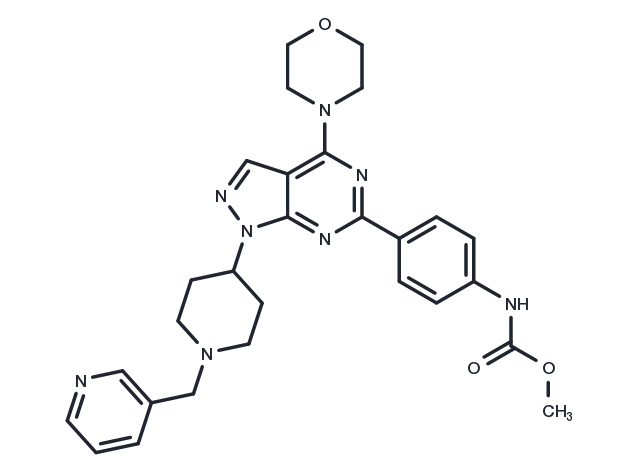Powder: -20°C for 3 years | In solvent: -80°C for 1 year
WYE-687 is an ATP-competitive and selective inhibitor of mTOR with IC50 of 7 nM; blocks mTORC1/pS6K(T389) and mTORC2/P-AKT(S473) but no effect observed on P-AKT(T308). Selectivity for mTOR is greater than PI3Kα (>100-fold) and PI3Kγ (>500-fold).

| パッケージサイズ | 在庫状況 | 単価(税別) | |||
|---|---|---|---|---|---|
| サンプルについてお問い合わせ | |||||
| 2 mg | 在庫あり | ¥ 8,000 | |||
| 5 mg | 在庫あり | ¥ 13,000 | |||
| 10 mg | 在庫あり | ¥ 21,000 | |||
| 25 mg | 在庫あり | ¥ 44,500 | |||
| 50 mg | 在庫あり | ¥ 68,500 | |||
| 100 mg | 在庫あり | ¥ 114,000 | |||
| 1 mL * 10 mM (in DMSO) | 在庫あり | ¥ 18,000 | |||
| 説明 | WYE-687 is an ATP-competitive and selective inhibitor of mTOR with IC50 of 7 nM; blocks mTORC1/pS6K(T389) and mTORC2/P-AKT(S473) but no effect observed on P-AKT(T308). Selectivity for mTOR is greater than PI3Kα (>100-fold) and PI3Kγ (>500-fold). |
| ターゲット&IC50 | mTOR:7 nM |
| In vitro | Immune-complex kinase assay shows mTORC2-specific substrate His6-AKT or the mTORC1 substrate His6-S6K is dose dependently inhibited by WYE-687. WYE-687 globally inhibits mTOR signaling and AKT function in cellular models dose dependently. WYE-678 profoundly inhibits cap-dependent and global protein synthesis in MDA361, human breast cancer cells. WYE-687 shows antiproliferative effects in various cancer cell lines involving G1 cell cycle arrest and selective apoptosis. WYE-687 down-regulate angiogenic factors, VEGF and HIF-1α, in U87 mg, MDA361 and LNCap cells. [1] |
| キナーゼ試験 | DELFIA Format of Purified FLAG-TOR: The routine assays with purified FLAG-TOR (FL and 3.5) are performed in 96-well plates as follows. Enzymes are first diluted in kinase assay buffer (10 mM Hepes (pH 7.4), 50 mM NaCl, 50 mM β-glycerophosphate, 10 mM MnCl2, 0.5 mM DTT, 0.25 lM microcystin LR, and 100 lg/mL BSA). To each well, 12 μL of the diluted enzyme is mixed briefly with 0.5 μL test inhibitor or control vehicle dimethyl sulfoxide (DMSO). The kinase reaction is initiated by adding 12.5 μL kinase assay buffer containing ATP and His6-S6K to give a final reaction volume of 25 μL containing 800 ng/mL FLAG-TOR, 100 μM ATP, and 1.25 μM His6-S6K. The reaction plate is incubated for 2 hours (linear at 1-6 hour) at room temperature with gentle shaking and then terminated by adding 25 μL Stop buffer (20 mM Hepes (pH 7.4), 20 mM EDTA, and 20 mM EGTA). The DELFIA detection of the phosphorylated (Thr-389) His6-S6K is performed at room temperature using a monoclonal anti-P(T389)- p70S6K antibody (1A5) labeled with Europium-N1- ITC (Eu) (10.4 Eu per antibody). Fortyfive microliters of the terminated kinase reaction mixture are transferred to a MaxiSorp plate containing 55 μL PBS. The His6-S6K is allowed to attach for 2 hour after which the wells are aspirated and washed once with PBS. One hundred microliters of DELFIA buffer with 40 ng/mL Eu-P(T389)-S6K antibody is added. The antibody binding is continued for 1 hour with gentle agitation. The wells are then aspirated and washed four times with PBS containing 0.05% Tween 20 (PBST). One hundred microliters of DELFIA Enhancement solution is added to each well and the plates are read in a PerkinElmer Victor model plate reader. Data obtained are used to calculate enzymatic activity and enzyme inhibition by potential inhibitors. |
| 細胞研究 | For cell cycle analysis, cells are seeded in 96-well culture plates at 10,000 cells per well for 24 hours, treated with various inhibitors for 24 hours or 48 hours. Following treatment, cells are harvested, washed with PBS and fixed overnight at -20 °C in 70% ethanol. Cells are washed, stained with propidium iodide and analyzed for cell cycle profile (acquired 5000 cells/well) on Guava PCA-96 instrument according to the Guava Cell Cycle Protocol(Only for Reference) |
| 分子量 | 528.61 |
| 分子式 | C28H32N8O3 |
| CAS No. | 1062161-90-3 |
Powder: -20°C for 3 years | In solvent: -80°C for 1 year
H2O: 60.2 mg/mL (100 mM)
DMSO: 60.2 mg/mL (100 mM)
You can also refer to dose conversion for different animals. 詳細
bottom
Please see Inhibitor Handling Instructions for more frequently ask questions. Topics include: how to prepare stock solutions, how to store products, and cautions on cell-based assays & animal experiments, etc.
WYE-687 1062161-90-3 Angiogenesis MAPK PI3K/Akt/mTOR signaling Tyrosine Kinase/Adaptors p38 MAPK Src mTOR PI3K Mammalian target of Rapamycin Phosphoinositide 3-kinase WYE 687 WYE687 inhibit Inhibitor inhibitor
